Well, I don't agree. More than any other genre, fighting games are all about characters. It's the characters who introduce the game, the characters who must be immediately appealing in their designs, and the characters who invite players to learn and master their favorites. And when you’ve spent hours perfecting controller gymnastics and analyzing combo attacks, it’s hard to NOT care a little about Scorpion getting revenge on Sub-Zero in Mortal Kombat, Sakura all but admitting she wants to have Ryu’s children in Street Fighter V, and whether or not every Samurai Shodown game since the second is a prequel just because Nakoruru is still alive.
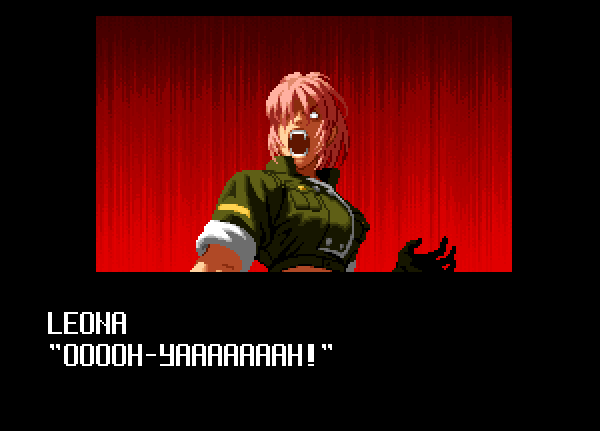
I can’t resist that. I do my best to dig into the mechanics and head-to-hear furor of fighting games, but the truth is that I'm much more into their ongoing character arcs. If a new Power Instinct game appeared tomorrow, my first question would be “Does it resolve Angela and Sahad’s rumored romance?”
Yes, I care about those dumb fighting-game stories, and I’ll prove it by picking five arcs in which I’m far too invested.
1. HIKARU AND LUPINUS
(Chaos Code)
The original Chaos Code almost gets it right. It lacks a decent online mode and other refinements one expects from a modern fighting game, but it has some intriguing characters, including a hulking chef, twins who function as a single combatant, and a manga author who changes cosplay with each combo attack. My personal favorites, however, are two special operatives: one has a cyborg arm, and the other has a body pillow with an anime girl on it.
Hikaru looks a lot like a typical fighting-game hero, apart from the anime-girl pillow he drags with him to every match in Chaos Code. In one of his story-mode endings, he’s congratulated by a fellow agent who asks him out for drinks and perhaps more. Hikaru’s on the verge of accepting until he remembers that a new otaku-bait video game is out, and he invites his co-worker along. She declines, apparently being unfamiliar with the phrase “fixer-upper.”

Chaos Code’s first expansion, New Sign of Catastrophe, tells us more. Hikaru’s co-worker is named Lupinus, and she’s a fully playable character with a cybernetic arm and a less cautious crush on Hikaru. By the end of the game, she's dragging him along on shopping trips.
There's no lack of nerd-fantasy fulfillment in modern fiction, but I enjoy the simple clash of Hikaru's brazen nerdery and Lupinus' more conventional tastes. As it turns out, she wasn't repulsed by his geek fixations. She’s just insecure about her robotic limb and, of course, her figure, because fighting games have told us that all women everywhere worry about their cup sizes to the point where it's a recognized disorder in the DSM-5.
And where will the long-in-development Chaos Code 2 take this? Will Hikaru get over his anime-wife fixations while Lupinus gets over her clichéd hang-ups? I suspect that I’m not alone in hoping for more of this subplot, since developer FK Digital's early promo art for the game shows Lupinus and Hikaru in formal wear.
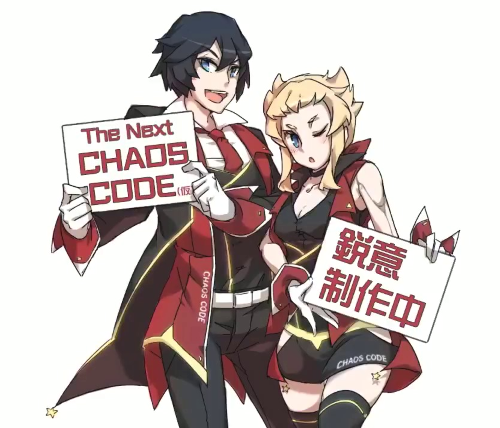
See? They know where that Chaos Code bread is buttered.
2. LEONA’S DARK SIDE
(The King of Fighters)
The King of Fighters has an unexpectedly elaborate backstory, perhaps because a lot of it doesn’t have to show up in the actual games. Leona Heidern is a good example. She’s a mainstay of the series, and we’re occasionally reminded that she’s a vessel for a murderous energy called Orochi. We’re reminded less often that Leona’s power manifested when she was a child and led her to massacre her entire village, and that mercenary leader Heidern just happened to show up and adopt her.
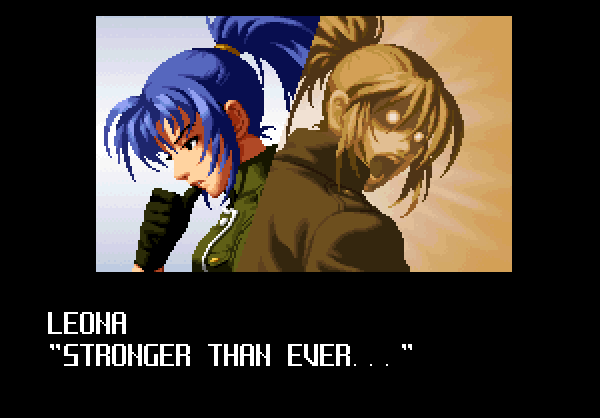
Hints appear in Leona’s cold, efficient manner and haunted moments, painting her as a woman finding out that she's really a monster. Too bad The King of Fighters doesn’t know what else to do with that intriguing idea. Just about every new game sees Leona burdened by the curse of her bloodline, sometimes to the point of attacking her comrades, but she inevitably bounces back and realizes that Heidern and his bickering soldiers, Ralf and Clark and Whip, are all the family she has. Indeed, the most recent King of Fighters sees an embodiment of Orochi defeated by other characters while Leona just sits in a briefing room and daydreams about murder.
SNK cares about Leona only as far as they can exploit her for sex appeal. Her outfit’s grown less practical as the series has progressed, and I don’t even want to talk about what she had to wear in SNK Heroines: Tag Team Frenzy. Then again, it may explain why she periodically wants to kill everything.
3. TEMPEST AND RAZOR
(BloodStorm)
I refuse to hide my fondness for BloodStorm at this point. It’s a tastelessly violent game from the darkest age of Mortal Kombat rip-offs, but it has a lot of small things going for it. Secrets arise at every turn, a password system lets you gain and store new abilities, and the stages are far more interactive than other fighters of its era. Even its post-apocalyptic world and stereotyped characters are the stuff of endearingly cornball ‘90s superhero comics, and I love that. The ice guy and the fire guy hate each other! The ice guy is named Freon! And the amazon queen who uses men like cattle lives in the Obsel desert! The kids’ll never pick up on that one!
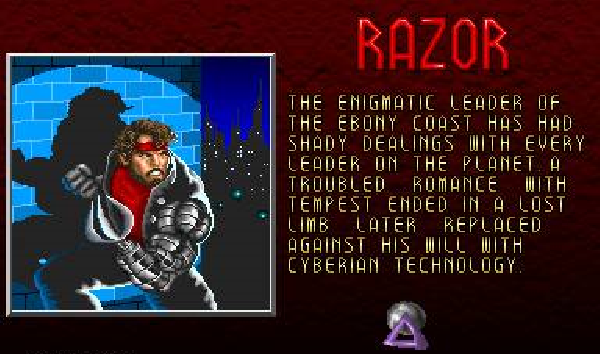
Amid this mess of feuding providences and Liefeldian overkill, we find Tempest and Razor. Tempest is the pompous daughter of the recently murdered emperor, Razor is a “handsome and crafty” rogue, and, years before the events of BloodStorm, the two of them were an item. The in-game bio suggests that Tempest ripped off Razor’s arm, but the Official BloodStorm Handbook, of which I own two copies, tells the real story. Their relationship angered the Royal Gene Matrix, which framed Razor for conspiracy and had him imprisoned and sold to the realm of Cyberia (get it?). There, the merciless machine overlord Talon turned Razor into a cyborg, while Tempest apparently bought into the Royal Gene Matrix’s story and never saw Razor again.
Not much comes of this. Razor’s ending sees him uniting all the other provinces in a war against Cyberia, while Tempest’s ending reveals her to be kinda stupid: she lets slip that she was the one who offed Emperor Dad, and she’s hauled to the execution block. And so BloodStorm is over, doomed to the same annals of obscurity as Survival Arts, Tattoo Assassins, and that one fighting game with rubbery dinosaurs. No, not Primal Rage. The older, more ridiculous one. Dino Rex.
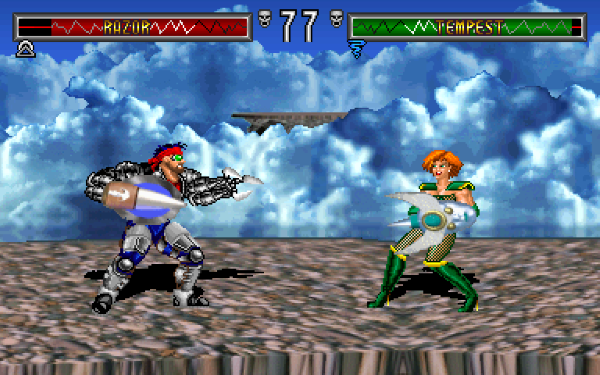
But I still have questions. Did Razor even try to reconcile with Tempest? Did Tempest murder her father after realizing that he and the Royal Gene Matrix had lied to her all those years ago? And what the hell is the Royal Gene Matrix, anyway? Is it a computer? Or some Bene Gesserit-esque cult obsessed with breeding a pure and perfect nobility? And why didn't Tempest just become empress automatically? Is this a democratic empire?
And did Razor and Tempest secretly have a kid, one who we might have seen in BloodStorm 2: Nekron Strikes Back? If Mortal Kombat's Johnny Cage and Sonya Blade can have a child, don't tell Razor and Tempest that they can't. It would perfectly top BloodStorm's delicious pulp comic sundae.
4. AXL, ZAPPA, AND MEGUMI
(Guilty Gear)
Guilty Gear is impressive for imposing even a vague sense of coherency on its reckless hybrid of anime spectacle and heavy-metal grandeur. It’s a place where a pirate girl (named after Brian May) might casually toss entire whales at a quasi-nun who wears a giant handcuff and wields a yoyo that transforms into a bladed teddy bear (probably named after Roger Taylor), but it respects its various story arcs and the fans insane enough to follow them. Guilty Gear Xrd Revelator has a staggering four hours of cutscenes that wrap up everything from Sol Badguy’s backstory to the true identity of longtime antagonist That Man. He’s really just a grumpy catboy.
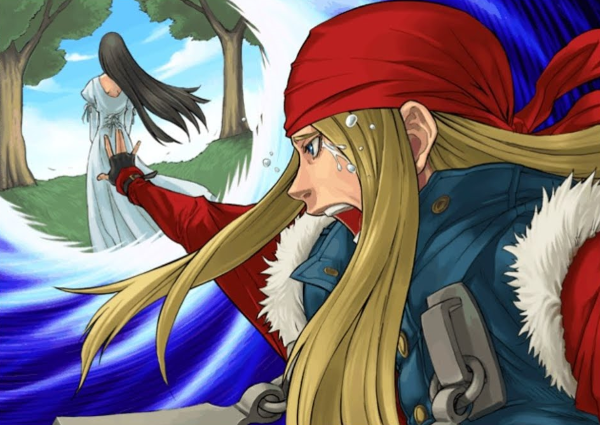
Some mysteries remain in the margins, however. Axl Low, a mainstay of the series and an obvious reference to Axl Rose, is a gang leader from the 20th century, displaced almost two hundred years into the future. He’s prone to coming unstuck in time and is somehow connected to the ominous antagonist known as Raven, but poor Axl really just wants to get back to his native era and see his girlfriend, Megumi Saito.
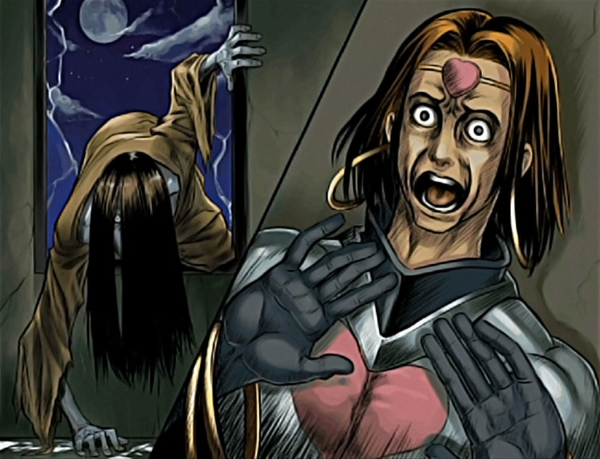
One of the weirder Guilty Gear fixtures is Zappa, a poor sap inhabited by several different ghosts. The most fearsome of these spirits is S-ko, a blatant and vengeful homage to Sadako from The Ring, and we’re told that she became a malevolent soul after her lover abandoned her and she threw herself down a well (of course). By the way, Guilty Gear doesn’t show much of Megumi, but she apparently had the same long black hair as S-Ko. Hmmm.
We have only this tenuous connection, but that’s all we need to speculate widely about just how Zappa and Axl’s stories are connected and how they might resolve each other. Presumably Axl could go back to his proper century and prevent Megumi from becoming a man-hating ghost, spawning more than a few paradoxes along the way and reinforcing the sexist concept that women are helpless and suicidal without men. Oh well. At least they'd have a happy ending.
Granted, the Guilty Gear series and creator Daisuke Ishiwatari probably would have dropped more than slight allusions if Megumi were truly S-ko, but they have to save something for the next game. Perhaps it'll have Megumi traveling to the future to exorcise herself.
5. JON TALBAIN AND FELICIA
(Darkstalkers)
Capcom isn’t likely to make another Darkstalkers game for two reasons. One: the unique Darkstalkers style of classic monsters, rendered with stretch-and-squash animation and goofy panache, would be hard to pull off in the modern 3-D mold that so many fighting games favor these days. Two: the last Darkstalkers reissue didn't make enough money.
If Capcom ever returns to Darkstalkers, though, I have my number-one stupid fan question ready and waiting: are Jon Talbain and Felicia an item or not?

There is zero sign of this in the actual Darkstalkers games. Jon Talbain, a British werewolf, never interacts with rambunctious catgirl Felicia, and they don’t appear in each others’ endings. Indeed, there’s more evidence that Felicia has a thing for Blanka from Street Fighter, thanks to a casual quip she makes.
So why do I wonder? Because the wolf and cat pair up in just about every Darkstalkers adaptation, from Run Ishida’s mediocre Night Warriors manga and the long-forgotten anime series to the more recent Udon comics, and, well, they're just cute together. Usually they’re friends or bickering allies, mixing Jon's gruff werewolf self-pity with Felicia's chipper faith in human-monster harmony. These are not expressly canon, but Capcom presumably has to rubber-stamp all of it, including this official Darkstalkers valentine.
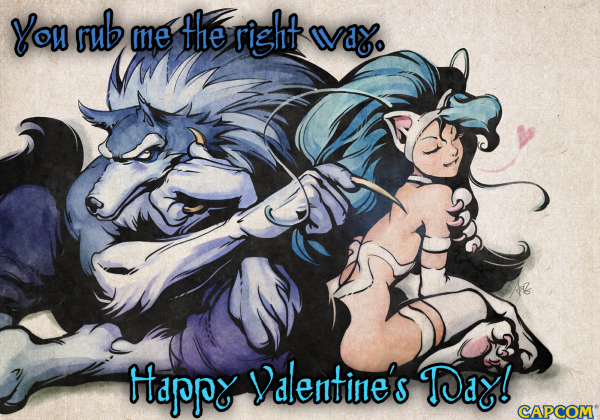
It has the Capcom logo! See? It's legally binding!
Darkstalkers doesn’t have any real overlying plot. In a way, that’s what keeps the series fun and approachable when stacked next to the daunting narratives of BlazBlue or Soul Calibur. Yet Darkstalkers excels in its characters, and the more we know about their relationships, the better off we are and the better-plotted our dreadful fan fiction will be. In the haphazard and abbreviated realm of fighting-game storylines, it's nice to have even a hint of clarity.

No comments:
Post a Comment